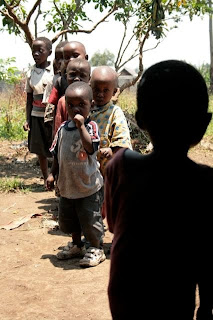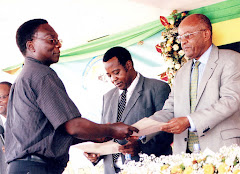The park is located at Mabibo suburb in Ubungo along Nelson Mandela Expressway in the city of Dar es Salaam, its location is 12 kilometers away from Dar es Salaam port and 14 kilometers from Mwalimu Nyerere International Airport. The project which was initially established by the President’s Office, Economic planning, Privatization and Empowerment during the third phase government has currently been transferred to the Ministry of Trade, Industries and Marketing. This is a world class industrial park for export processing zones developed solely by the government of Tanzania under the strategy known as “The Tanzania Mini-Tiger Plan 2020” which is aimed at contributing to the acceleration of the growth of Tanzania’s Economy to between 8-10 percent GDP growth.


An aerial view of part of the BWM-SEZ at Mabibo suburb in Dar es Salaam. The most fascinating architectural design of the building is that shopping mall which has been designed with a curved structure on its façade.
The Mini-Tiger Plan 2020 is the strategy designed to build Special Economic Zones
needed to fast track the implementation of National Strategy for Growth and Reduction of Poverty popularly known as “MKUKUTA” with the aim to create between 2-3 million new jobs by year 2020. The government has already spent about Tshs. 36.5 billion towards the cost of construction of BWM-SEZ which is the largestin the country covering an area of about 259,400.49sqm. This is 52 hectares which is
equivalent to 125 acres of land. Report by EPZA shows that, out of Tshs. 35.6 billion, 31.7 billion being the cost of construction of civil works, buildings, drainage works,landscaping, electrical and telephone installation. Tsh. 4.8 billion has been spent under a separate contract for the design and construction of the 33KVA power sub-station. However, the total cost of the project is expected to reach about Tsh. 40 billion at completion.

An electricity sub-station is one of the major facilities which has been made available to cater for the need of electricity during power cuts within the BWM-SEZ. Other infrastructures such as roads and water drainage systems are all in good place.
Efforts are being undertaken by EPZA to hire large portion of this land to the prospective investors to run their businesses in light manufacturing and processing industries and labour intensive which would later earn the government with money. BWM-SEZ offers serviced land for lease and the plot sizes ranges from 300 sq meters to 11,000 sq meters. Each plot has connectivity points for water, electricity, gas, fire fighting system and sewerage system. The rental fee is 60 cents per sq meter per annum payable 10 years in advance, and the lease term is 33 years. According to the Director General of the EPZA, Dr. Adelhelm Meru, investors will also be required to pay a monthly service fee to cover for common services. In addition to the lease of serviced land, the BWM-SEZ welcomes investors who want to rent factory space. Construction of the factory sheds is at its final stage. The park also offers office space for lease to companies providing services to the park. Investors who succeed to be leased with plots within BWM-SEZ are expected to start construction of their industrial structures by end of 2009. It is expected that, in three years time (i.e by 2012) industries within BWM-SEZ will be full in operational.

This is a dispensary within BWM-SEZ, the building will be used for first aid medical treatment to workers of the factories within and not for out patient
Currently the construction work of buildings at the BWM-SEZ project site is completed and the main contractor is busy handing over some parts of the buildings to their client. The finished buildings are the administrative block which houses the main office of the Export Processing Zones Authority (EPZA). Other buildings are the dispensary to be used as a first aid clinic for workers inside the zone, a cafeteria, an impressive shopping arcade designed with an arch structure roof which would be used to sell manufacturing products within the zone, a fire station building and a customs house. The fire station would be installed with the special machines whose sense would detect fire within 25 radius kilometers, thus safety would be ensured at the zone from any possible dangerous fire occurrence within the zone. Apart from the buildings, the zone is equipped with the necessary infrastructure facilities These includes, a 33KVA power sub-station, a reliable gas distribution system connected to Songas pipelines, and a reliable sewerage disposals.

This is a fire building which is strategically designed with an open space on which to park fire vehicle.
There is underground network of electricity as well as telephone cables and water hydrant point in every plot. The electricity power station has been constructed in order to receive more power to feed the transformers which are to be installed later within the zone. The sewerage disposals would be pumped through a channel of storm water in a large ditch constructed close to the operating light industries within the zone, this would be later pumped outside to circulation point treatment or oxidation point Others are underground water reserve tank with a capacity of 4.5 million litters constructed with an underground depth of 9 meters deep designed to meet the water demand for 24 hours, a reliable fire fighting systems. Currently there are already finished supporting buildings for one stop service centre. This is after an intensive construction work of a land survey which was done by a team of architectural experts from the Dar es Salaam based Ardhi University which had also been supervising the work at the site for the last five years.

A structure made like mount Kilimanjaro monument at BWM-SEZ is an exciting landmark feature within the economic zone area. The feature has become an attraction to passersby who can view it clearly from outside the gate.
The initial construction phase started in August 2002 and ended up in 2005. The second phase continued and the main contractor, a locally registered class one construction company, Tanzania Building Works Ltd kept the construction at much faster pace in order to finish on the agreed date. BWM-SEZ is a landmark project whose construction lies on plot “No. 1081 Block B”. Among the most distinguishing feature which can be found within the project site is a structure made like mount Kilimanjaro monument which is a 9 meter high from the ground, stationed strategically few meters away from the main gate. The structure is architecturally designed on its top which is put the white stones at the peak to imitate the snow cap and the green robust ground cover to imitate the Kilimanjaro tundra, and high rise ground cover to imitate the intermediate trees.


The main gate is designed with a special covering material on top of the security building. This is a unique and a modern style building.
Right from the beginning the master plan of the project favoured the site as the most convenient one for the allocation of the SEZ project so as to attract local and international investors to enjoy the benefits and privileges of the SEZ, and Dar es Salaam being the main port of Tanzania, has good capacity to handle production from the SEZ. Its location in the suburb presents no problem to would be tenants because of its proximity to the local people and its conveniences it offers. “The construction is a good example of such a development an export economic processing zone needed for commercial purpose in semi-urban areas” Detailing from the architectural point of view, buildings at the BWM-SEZ project are decorated with high quality window glass fixed on steel aluminum products which have been supplied by Shamo Industries Ltd, a locally registered class one specialist contractor by CRB.

All buildings at the BWM-SEZ are decorated with alluco board, these are aluminium products used for decoration in buildings. It demonstrates high technology application by use of modern construction materials.
Aluminum and glazing are becoming an integral part in construction industry worldwide. The façade of each building at the site is decorated by using sheet glass which exhibits a more contemporary architectural design that provides an aesthetic beauty. The structured glazing looks darkish from outside and has been fixed on aluminum frames also supplied by Shamo Industries Ltd. Part of the external wall has been done by using a wall covering material called alluco board, this is a metal product joined with black fillers. The firm has laid down a success story in its endeavors of their manufacturing to international quality standards. The firm buys these materials from Italy and UK in order to meet the current demand of good product quality for aluminum and glass products of various colors and shapes. Other construction companies which took part in the project is Derm Electrical Company, a class one registered by CRB, specialized in Electricity and Air-conditioning systems. The firm did electrification work in every building within the zone.

The entire roads network within BWM-SEZ which have also been designed for pedestrians
Pedestrian walkways and spaces at the SEZ are designed to encourage walking through and around each Development Plot with basic principles that Provide separation between pedestrian and vehicle movements, and well defined separation of pedestrian paths from parking areas to building entrances. They also provide safe and convenient pedestrian walkways between buildings, paved areas and a free easy access for wheeled traffic, disabled and services to be according to relevant regulation in the use of ramps and proper dimensioning of access roads.EPZA is mandated to plan, develop and maintain an economic processing zones in some few selected areas in the country. The mission of the authority is to promote an adequate, safe and well maintained zone so as to effectively contribute to the social-economic development. In view of this, the authority is struggling to get areas of more economic zones and some areas have been earmarked for development such as Bagamoyo, Tanga, Arusha and Mtwara. The BWM-SEZ at Mabibo is the pilot project



















